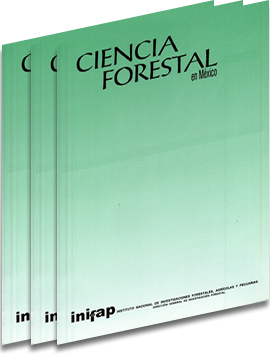VARIACIÓN GEOGRÁFICA EN LA RESPUESTA A LA SEQUÍA EN PLÁNTULAS DE Pinus greggii Engelm.
Palabras clave:
Adaptación a la sequía, déficit hídrico, distribución de biomasa, Pinus greggii, tolerancia a sequía, variación geográficaResumen
Se evaluaron plántulas de 15 poblaciones de Pinus greggii procedentes de dos regiones geográficas, bajo dos niveles de humedad del suelo en condiciones de invernadero, con el objeto de determinar el efecto del estrés hídrico sobre el crecimiento en altura y en la acumulación y distribución de biomasa de las plantas. Se obtuvieron diferencias significativas entre regiones geográficas y poblaciones dentro de éstas en cuanto al crecimiento en altura. Los resultados indican que, en general, las del norte de México que tienen menor porte, fueron afectadas en menor grado por el estrés hídrico en su crecimiento y presentaron un mayor número de raíces y mayor peso seco de raíz que las del sur. Además, su crecimiento potencial (bajo condiciones favorables de humedad) se correlacionó en forma positiva con el impacto del déficit de humedad del suelo. Todas estas características hacen que las poblaciones del norte sean más tolerantes a la sequía. La respuesta de las plantas al estrés hídrico estuvo especialmente con la precipitación promedio anual. Las poblaciones de lugares muy relacionada con las condiciones climáticas del sitio de origen de la semilla, más secos con mayor latitud y altura sobre el nivel del mar, fueron más tolerantes a la sequía.
Descargas
Descargas
Publicado
Cómo citar
Número
Sección
Licencia
Los autores que publiquen en la Revista Mexicana de Ciencias Forestales aceptan las siguientes condiciones:
De acuerdo con la legislación de derechos de autor, la Revista Mexicana de Ciencias Forestales reconoce y respeta el derecho moral de los autores, así como la titularidad del derecho patrimonial, el cual será cedido a la revista para su difusión en acceso abierto.
Todos los textos publicados por la Revista Mexicana de Ciencias Forestales –sin excepción– se distribuyen amparados bajo la licenciaCreative Commons 4.0 Atribución-No Comercial (CC BY-NC 4.0 Internacional), que permite a terceros utilizar lo publicado siempre que mencionen la autoría del trabajo y a la primera publicación en esta revista. (no permite el uso comercial)
Los autores pueden realizar otros acuerdos contractuales independientes y adicionales para la distribución no exclusiva de la versión del artículo publicado en la Revista Mexicana de Ciencias Forestales (por ejemplo, incluirlo en un repositorio institucional o darlo a conocer en otros medios en papel o electrónicos) siempre que indique clara y explícitamente que el trabajo se publicó por primera vez en la Revista Mexicana de Ciencias Forestales.
Para todo lo anterior, los autores deben remitir el formato de carta-cesión de la propiedad de los derechos de la primera publicación debidamente requisitado y firmado por los autores/as. Este formato debe ser remitido en archivo PDF al correo: editorial.forestal@inifap.gob.mx
Esta obra está bajo una licencia de Creative Commons Reconocimiento-No Comercial 4.0 Internacional.


